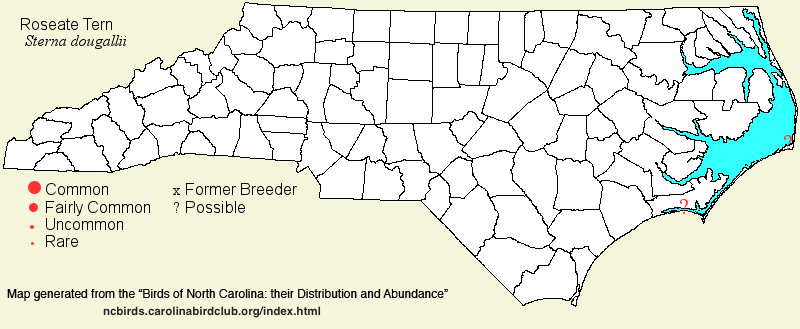 |  |
|
Roseate Tern - Sterna dougallii LARIDAE Members: | Search Common: Search Scientific: |
|
|
|||||||
| General Comments | The Roseate Tern is one of the more elegant and graceful of the tern species, and because it is a globally rare species -- Federally listed in the United States -- the sighting of one in the state is always memorable. Though Roseate Terns nest in both the New World and in the Old World, its nesting populations are highly fragmented, and the relatively small population in the Canadian Maritimes and northeastern United States is highly monitored/managed (to keep gull and other predator populations controlled). It is strictly coastal/oceanic, and birds reach the breeding grounds essentially out of sight of land; one may try to find a Roseate Tern by taking a pelagic trip, but few trips see the species. Fortunately, there are numerous coastal records, and the species has actually nested along the coast on one occasion, and possibly has done so on a few other occasions. There are literally no inland records (including the Tidewater zone), including a lack of storm-carried birds to inland lakes. Roseates winter south of the United States. There has been a considerable number of northern coast reports, and our two highest counts ever, mainly from shore in Dare in summer and fall 2023 and 2024, continuing into 2025, possibly suggesting a population increase in the breeding population to our north. | ||||||
| Breeding Status | Accidental Breeder | ||||||
| NC BRC List | Definitive | ||||||
| State Status | E | ||||||
| U.S. Status | E | ||||||
| State Rank | SHB | ||||||
| Global Rank | G4 | ||||||
| Coastal Plain | Transient and summer visitor coastally and offshore. In the warmer months, rare along the northern and central coasts (including the offshore zone), south to Carteret; very rare along and off the southern coast. There were a remarkable number of coastal records for Dare and even Currituck in summer 2020, though there was no strong indication of breeding; another flurry of numerous birds came in summer and fall 2023, and in fall 2024, along the Dare and Carteret coasts. Every few years, one or two birds in full breeding plumage appear in breeding colonies of other tern species, seemingly acting as if breeding. However, the only conclusive nesting was in the Cape Lookout area, on 23 May 1973, when a pair with two eggs was observed [Chat 39:20-21 link]. Main occurrence from early May to early Sep, sparingly to late Oct. There are, oddly, no Apr records, but a specimen found on 20 Jan 1937 at Cape Hatteras (Birds of North Carolina) is remarkable, though one wonders how long the bird had been dead, as this species is essentially absent in the country after Oct. Peak counts: 76, from Cape Hatteras point, 22 Aug 2024; 64 at that point, 24 Aug 2024; 20, offshore, 9-10 Sep 1979 (after Hurricane David); 17 (all adults) around Cape Hatteras Point (Dare), 3 Aug 2023; 16 at Cape Hatteras Point, 15 Jun 2020; 12 at Cape Hatteras Point, 12 May 2022; 8 at the northern end of Pea Island NWR, 23 Jun 2022; 7 on five dates. | ||||||
| Piedmont | No records. | ||||||
| Mountains | No records. | ||||||
| Finding Tips |
The most likely spot to find this species used to be in the tern colony at Cape Hatteras Point, but this colony has disappeared in recent years. The best chances now are to hope for a visitor to the beaches near Cape Hatteras Point, in tern colonies along the coast, or on a pelagic trip in the latter half of May (not a good chance). Small numbers have been regularly seen along beaches in Dare in spring and summer 2023, and late summer 2024, for example. * to ** | ||||||
| Attribution | LeGrand[2025-07-26], LeGrand[2025-01-30], LeGrand[2024-02-10] | ||||||
| NC Map Map depicts all counties with a report (transient or resident) for the species. | Click on county for list of all known species. |
| NC Breeding Season Map Map depicts assumed breeding season abundance for the species. |  |